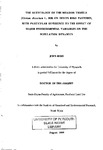THE AUTECOLOGY OF THE MEADOW THISTLE (Cirsium dissectum L. Hill) ON DEVON RHoS PASTURES, WITH PARTICULAR REFERENCE TO THE EFFECT OF MAJOR ENVIRONMENTAL VARIABLES ON THE POPULATION DYNAMICS
| dc.contributor.author | ROSS, JOHN | |
| dc.contributor.other | School of Geography, Earth and Environmental Sciences | en_US |
| dc.date.accessioned | 2013-10-30T11:38:31Z | |
| dc.date.available | 2013-10-30T11:38:31Z | |
| dc.date.issued | 1999 | |
| dc.identifier | NOT AVAILABLE | en_US |
| dc.identifier.uri | http://hdl.handle.net/10026.1/2474 | |
| dc.description.abstract |
Semi-natural wet grassland communities are rapidly disappearing from the farmed landscape. Protection of remaining areas and restoration of degraded areas has become a priority with organisations concerned with the conservation of biodiversity in the U.K. The research described in this thesis provides an insight into the community dynamics of one particularly rare plant community, the Cirsio-Molinietum fen meadow (NVC M24). This was achieved by examining the autecology of Cirsium dissectum, one of the key indicator species of this community. The habitat environment where C. dissectum is present was characterised at eight Devon M24 locations and ten non-M24 locations. This revealed a particularly unique suite of environmental conditions. Soil water content was found to be relatively high with little seasonal fluctuation. Mineral nutrient status was characterised by particularly low phosphorus, below optimal nitrogen, ample calcium and potassium and a soil pH which was only mildly acid. The physiological characteristics of C. dissectum were determined by a series of controlled experiments. The species exhibited a high water requirement but was relatively tolerant of drought stress and prolonged dehydration. It was demonstrated that C. dissectum is well adapted to a low phosphorus environment, is tolerant of nitrogen levels considered below optimum for many plants and is relatively tolerant of shade. It can also recover from partial or total defoliation in a relatively short period of time without any loss in plant mass or carbohydrate reserves. From the physiological characteristics, it was concluded that C. dissectum conforms to the "stress-tolerant competitor" functional type. It was also concluded that the decline of the species is directly related to loss of habitat as a result of its degree of specialism and specific niche requirement. The implications for management of existing sites and restoration of degraded sites is discussed and an outline model of appropriate management actions is presented. | en_US |
| dc.description.sponsorship | The Institute of Grassland and Environmental Research, North Wyke | en_US |
| dc.language.iso | en | en_US |
| dc.publisher | University of Plymouth | en_US |
| dc.title | THE AUTECOLOGY OF THE MEADOW THISTLE (Cirsium dissectum L. Hill) ON DEVON RHoS PASTURES, WITH PARTICULAR REFERENCE TO THE EFFECT OF MAJOR ENVIRONMENTAL VARIABLES ON THE POPULATION DYNAMICS | en_US |
| dc.type | Thesis | |
| plymouth.version | Full version | en_US |
| dc.identifier.doi | http://dx.doi.org/10.24382/3707 | |
| dc.identifier.doi | http://dx.doi.org/10.24382/3707 |
Files in this item
This item appears in the following Collection(s)
-
01 Research Theses Main Collection
Research Theses Main


